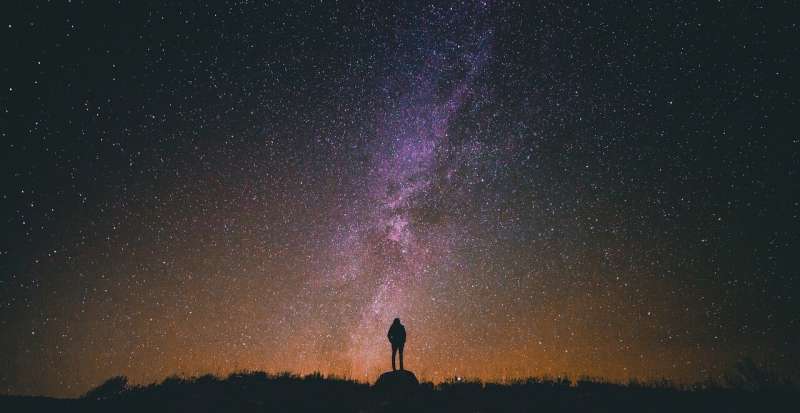Dark sky tourism offers time with darkness and celestial wonders

Lisa Lock
scientific editor

Andrew Zinin
lead editor

On a cold winter night in a rural area, I looked through a scope to see the rings of Saturn for the first time. Connecting grade school science book descriptions with a real-life view amazed me.
Even without a telescope or binoculars, many of us have had similar memorable moments—like watching the Milky Way, identifying constellations and safely observing a solar eclipse.
are places mostly free of light pollution and where one can see celestial features easily. Dark skies can be awe-inspiring, but they for both animal health, human health and local economies.
Even though our current night skies have become polluted with excessive light, there are ways to promote understanding, reduce light pollution and support local communities. defined dark sky tourism (DST) as "tourism based on unpolluted night skies involving observation and appreciation of naturally occurring celestial phenomena."
My and I have researched factors contributing to the . This research was informed by our combined expertise studying protected areas and environmental education (my areas) and sustainable rural communities (Banack's area).
Wildlife, humans need night and darkness
Dark skies are important and humans have evolved to rely on predictable patterns of dark and light. For example, some amphibians plan their breeding rituals around darkness patterns. Hatchling sea turtles use the bright sea horizon to find the sea. Many mammals and birds hunt at night, using natural light from the moon and stars.
In response, some species evade their predators using the cover of darkness. Many birds migrate at night with the help of cues from the dark skies. , past and present travelers have planned navigation using dark skies.
The amazing many cultures in the realms of science, religion, philosophy, art and literature. Regular schedules of dark and light help us live and sleep well.
Negative effects of light pollution
Unfortunately, light pollution can cause negative effects. For example, artificial light , changes the timing of reproduction and reduces concealment for prey animals. Nocturnal predators are less effective in catching prey. in unnaturally high densities.
Furthermore, humans are affected by light pollution, with impacts on our natural circadian rhythms and sleep patterns, which may lead to other more serious health problems. Up to can't see key night sky features.
Aside from the environmental effects, the financial costs are high: in the United States alone, researchers estimate the financial cost of wasted energy from light pollution .
Dark sky tourism
Despite the spread and impacts of light pollution, many people actively seek out dark skies. , based on the number of visits to astronomical observatories, development of dark sky preserves, watching auroras, dark sky festivals, solar eclipses, star parties and sky-watching domes.
There are no accurate estimates of the size of DST, but many tourism sites indicate significant visitation and economic impact. For example, research published in 2019 found that dark sky enthusiasts spend more than visiting , creating 10,000 jobs.
Yellowknife has been called the aurora capital of North America with an average and suitable conditions to view the northern lights. In 2018, about 34,000 visitors in the Northwest Territories capital.
Local economic benefits
The large demand for DST and the local economic benefits are strong motivations for maintaining dark skies. Dark sky tourists want reliable opportunities to view the night sky and seek out guided educational programs to support those activities. Communities offering such tourism tend to support these same goals in order to maintain economic impacts.
Some organizations promote efforts to reduce light pollution through advocacy, education, retrofits and the designation of certified dark sky sites.
These night sky advocate groups want to minimize light pollution by limiting brightness on lights, using sensors and timers, changing light hues, minimizing the number of lights and directing lights downward.
Canadian dark sky sites
To certify such efforts, recognizes more than 200 dark sky places in 22 countries.
The recognizes 27 dark sky sites across the country, including dark sky preserves, nocturnal preserves and urban star parks, each with unique approaches to reducing lighting.
Canadian sites include , in Ontario (most southerly), in Newfoundland (most easterly) and in British Columbia (most westerly), as well as , which spans the Alberta and Northwest Territories border. These and other dark sky sites are natural attractions for dark sky tourists.
Jasper dark sky preserve
Following the designation , the annual has sought to promote dark skies among the public and policy-makers and to reduce artificial light.
The festival is held during . Despite the damage in Jasper from wildfires in 2024, the festival will celebrate its 15-year anniversary this fall.
After a small-scale start (with aspects like night-time walks and telescope viewing), the festival with some ticketed events and a range of options, including and cultural events. People can choose from both free and paid activities.
As our research examined, the has depended on the dark sky designation, balance between growth and sustainability, balance between education and entertainment, strong relationships with stakeholders, local champions, community support and a strong reputation. The economic impacts on Jasper have been positive during a season that normally under-utilizes local restaurants and hotels.
Dark sky tourism can help protect dark skies by generating support among and among communities receiving economic impacts. Such impacts may persuade decision-makers to enact policies to protect dark skies, such as dark sky preserves that have worked well in places like Jasper.
During your next night-time outing, be sure to look upward to appreciate our amazing dark skies, and consider the benefits for tourists and communities alike.
Provided by The Conversation
This article is republished from under a Creative Commons license. Read the .![]()



















